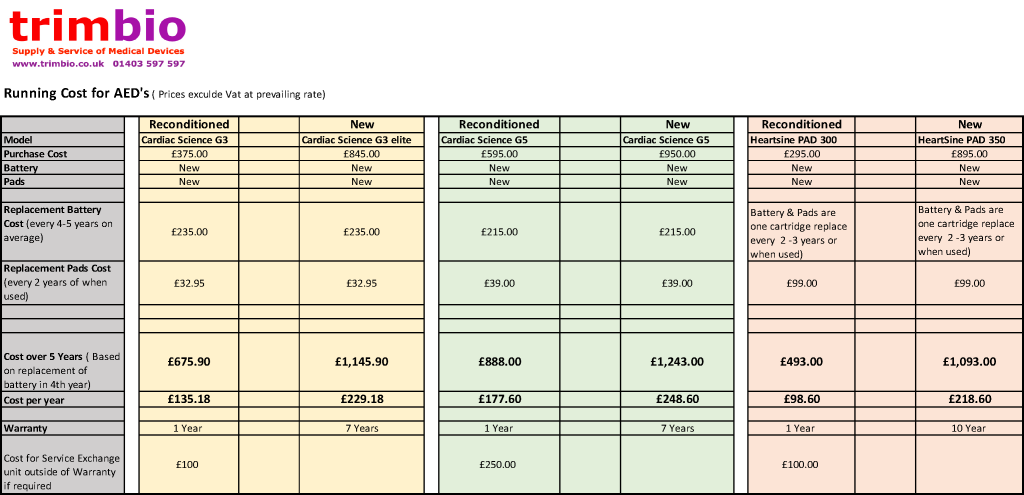When choosing an AED for use in the community, workplace or an organisation there are many questions that get asked about the type of device that will be best for you. Below we hope to answer most of these questions, however please do not hesitate to contact us for more information.
AEDs are sophisticated devices that use technology to ensure that only patients that require defibrillation receive it. They have a built in test system that carries out different tests & checks on the internal workings of the unit every day, every week and every month to ensure the unit is fully functional. If any of these tests fail or the battery is getting low, then the AED will warn you that attention is required; the same way that your smoke alarm works in the home.
New or Reconditioned AEDs?
Trimbio are one of the only companies in the UK that are fully-insured to recondition and recycle AEDs. We have a dedicated workshop with the appropriate test equipment and tools to ensure that any AED leaving the building is fully-functional as per the original manufacturers specification and carrying out full output tests to measure the energy delivered by the shocks. We also update the devices software to ensure that all AEDs have the latest Resuscitation Council Protocols loaded.
Based on the above, new or reconditioned AEDs will do the same job (deliver a shock to the patient if required). However the biggest differences are:
1 - Price
Reconditioned devices start from around £200+vat. New defibrillators start from approximately £700+vat.
2 - Warranty (base unit)
New AEDs will be supplied with a manufacturer's warrant, this can vary from 5 to 8 years. Some reconditioned devices will still have original manufacturers warranty left on them and if not, they will include a 1-year Trimbio warranty instead.
3 - Features
Some newer devices will have more features, one such example is a compression assistance pad to help the user carry out more effective CPR, however as with most items these features will be reflected in the price.
4 - Battery Life
All AEDs require replacement batteries from time-to-time, as you would expect, all new devices will come with a new battery that will generally last 4-5 years. Reconditioned devices are supplied with either a new battery, lasting 4-5 years or part used with a % life left in them. 50% would give approx. 2-3 years life, where 25% would give 1-2 years life.
5 - Electrodes Pads Life
All new and reconditioned AEDs are supplied with new electrode pads, these normally have a shelf life of 2 years minimum.
6 - Paediatric Use
If your requirements are for Paediatric use (child under the age of 8 or below 25kg in weight) then it can be useful to have a set of paediatric electrode pads. These are small size electrode pads and either have an energy reducer built in or the AED can be switched to paediatric use. If no paediatric electrode pads are available, then guidance states adult electrode pads can be used and if required due to the size of the patient being small, the electrode pads should be applied with one on the front of the patient’s chest and one to the back of patient. Paediatric electrodes pads are much higher in price than adult electrode pads and therefore are normally only purchased if the AED is being placed in an area that has a significant number of children present, such as near a school or sports centre.
Automatic or Semi-Automatic AEDs?
Even though the A in AED stands for automated, there are actually two types available. Semi-Automatic or Fully-Automatic. They both require the user to open/turn on the AED and then attached the electrode pads to the patient’s bare chest, from there onwards, the AED will then talk the user though what is happening and what to do, including when to administer CPR to the patient. The Defibrillator will not shock the patient if the patient’s heart is not in a shockable rhythm, ensuring that a patient that is still alive and their heart is beating will not receive a shock.
Fully Automatic AEDs – will carry out the whole process of analysing the patient’s heart rhythm and advises if the patient requires defibrillation. It will also deliver the electric shock to the patient automatically if required, without the user having to touch the device.
Semi-Automatic AEDs - are just the same as fully automatic AEDs apart from the delivery of the shock to the patient, they require the user to deliver the shock once being advised to do so by the device.
Which one should I choose?
Both devices give clear concise instruction during usage by verbal communication and also text on the device screen.
A Semi-Automatic AED gives more control over the shock delivery with the shock only being delivered by a shock button which flashes when pressed. This reduces the risk of a shock being delivered while someone is touching the patient, i.e performing CPR or a loved one holding a hand.
A Fully Automatic AED can be used by the most hesitant of users, such as a loved one that may not be able to press the shock button.
How much does a defibrillator cost?


